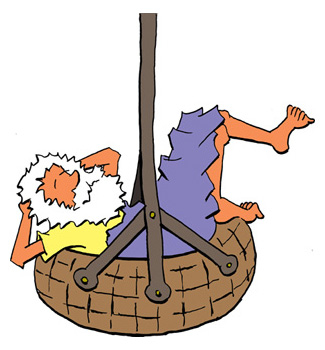"If-Then" Tables Explained
Sans Doute
(Part 6)
So far we've filled in all rows of the "If-Then" Truth Table.
| Truth Table: If-Then Statements | ||
| A | B | A → B |
| TRUE | TRUE | TRUE |
| TRUE | FALSE | FALSE |
| FALSE | TRUE | TRUE |
| FALSE | FALSE | TRUE |
But you might object that all we've done is by an empirical demonstrations using a deck of cards. So this table is fine for dealing blackjack, but is it valid for all mental reasoning in philosophy?
Well, the answer is yes.
But Captain Mephisto, I've often wondered how you could determine the Truth Values of the "If-Then" Table by reasoning alone.
No doubt you have. To do that we have to decide what If-Then really means.
Suppose you want to take a course in philosophy. But one of your friends had done so gives you the following advice:
Don't study philosophy or you'll go nuts.
Now what is you're friend actually saying?
Well, it's a two part statement based on two sentences:
Study philosophy
You'll go nuts.
... which we represent by:
| Study philosophy. | ≡ | SP |
| You'll go nuts. | ≡ | GN |
So we add the "Not" symbol, ¬ before SP and then link the two parts by the "Or" symbol, ∨. So we now have
¬SP ∨ GN
... which means:
Don't study philosophy or you'll go nuts.
Now the "Or" statements have a Truth Table, too. And it's pretty easy to understand.
| Truth Table: Or (∨) | ||
| A | B | A ∨ B |
| TRUE | TRUE | TRUE |
| TRUE | FALSE | TRUE |
| FALSE | TRUE | TRUE |
| FALSE | FALSE | FALSE |
So an "Or" statement is only FALSE if both the individual parts are simultaneously FALSE.
Notice this is what we call the inclusive meaning of "Or". So if we say "I'm going to New York or Boston", then if you go to New York or to Boston the statement is TRUE. But if you actually go to both, the statement is still TRUE. Only if you go to Saskatoon or Toronto but neither New York or Boston is the statement FALSE.
[Note: There is a way to logically express "A OR B but NOT both", but we'll skip that for now.]
But back to the advice from your friend.
Remember he said don't study philosophy or you'll go nuts. But what does he actually mean.
Well, what he means is that IF you DO study philosophy, THEN that means you will go nuts. That is:
Don't study philosophy or you'll go nuts.
... means the same as:
If you study philosophy, then you'll go nuts.
... which we can now easily represent symbolically as:
¬SP ∨ GN
... is the same as:
SP → GN
If you're still not convinced we can prove the matter logically. We do that by showing that the TRUTH TABLE for NOT-OR sentences are the same as IF-THEN.
We start out by writing the TRUTH TABLE for the "not" symbol, ¬. It's pretty simple.
| Truth Table: Not (¬) | ||
| A | ¬ A | |
| TRUE | FALSE | |
| FALSE | TRUE | |
We can now write the general sentence:
¬A ∨ B
... and make a "Not-Or" Truth Table.
We start off with just the assigned values of A and B.
| A | ¬ A | B | ¬A ∨ B |
| TRUE | ? | TRUE | ? |
| TRUE | ? | FALSE | ? |
| FALSE | ? | TRUE | ? |
| FALSE | ? | FALSE | ? |
... and we fill in the ¬A column (which is easy)
| A | ¬ A | B | ¬A ∨ B |
| TRUE | FALSE | TRUE | ? |
| TRUE | FALSE | FALSE | ? |
| FALSE | TRUE | TRUE | ? |
| FALSE | TRUE | FALSE | ? |
And now if you go back to the "Or" Truth Table, we can fill in the last column, the truth values for ¬A or B.
| A | ¬ A | B | ¬A ∨ B |
| TRUE | FALSE | TRUE | TRUE |
| TRUE | FALSE | FALSE | FALSE |
| FALSE | TRUE | TRUE | TRUE |
| FALSE | TRUE | FALSE | TRUE |
And we can now compare the ¬A ∨ B with A → B
| A | B | A → B | ¬A ∨ B |
| TRUE | TRUE | TRUE | TRUE |
| TRUE | FALSE | FALSE | FALSE |
| FALSE | TRUE | TRUE | TRUE |
| FALSE | FALSE | TRUE | TRUE |
So the two statements are completely the same:
How about that?
